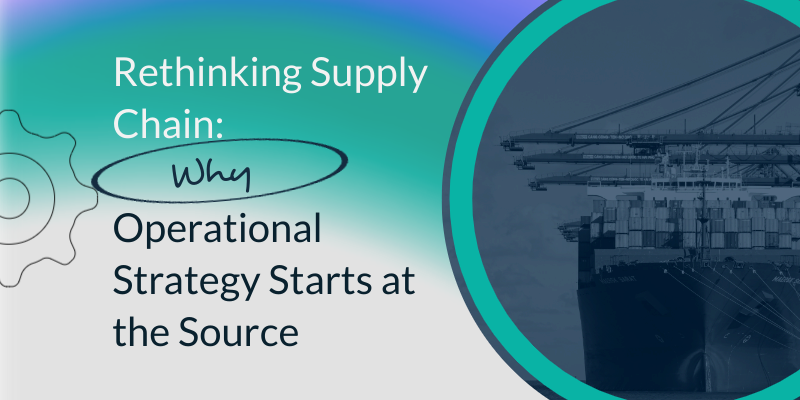Building Resilience: Understanding and Overcoming Internal and External Supply Chain Challenges for Sustainable Growth
Businesses will always face a variety of challenges, both internal and external. However, by continuously identifying, addressing, and adapting to these challenges, companies can create a solid foundation for long-term growth and success.
Issues in the internal and external supply chain don’t happen overnight; they unravel over time. While, in theory, that may sound obvious, you may be surprised by how many leaders try to resolve major supply chain issues without getting to the root of the problem. To effectively address supply chain issues, it is essential to understand the underlying causes and take a holistic approach that considers both internal and external factors.
Internal supply chain issues refer to problems within the company’s own operations. These may include inadequate inventory management, delays in production processes, or inefficient communication between departments. On the other hand, external supply chain issues are caused by factors outside of the company’s control, such as disruptions in logistics or changes in market demand.
Internal Challenges
Internal challenges or operational gaps are issues within the business that didn’t evolve overnight and are usually far more complex than one may think. These challenges can hinder the growth and success of a company if not addressed properly. Some common internal challenges that businesses may face include:
- Inefficient processes: Many companies have processes in place that are outdated, inefficient, or simply not effective for their current operations. This can lead to wasted time, and resources, and ultimately affect the overall productivity of the business.
- Lack of communication: Communication is crucial for any successful business, but often there are breakdowns in communication between departments, teams, or even individual employees. This can lead to misunderstandings, and delays in projects, and ultimately affect the quality of work being produced.
- Poor management: A strong and efficient management team is essential for a thriving business. However, poor management practices such as micromanagement, lack of clear direction and goals, or favoritism can create a toxic work environment and hinder the success of the company.
- Employee turnover: High employee turnover rates can be a major challenge for businesses. Constantly having to hire and train new employees is not only expensive but also affects the overall morale and stability of the company.
- Resistance to change: In today’s fast-paced business world, being able to adapt and evolve is crucial. However, many businesses struggle with employees or even management resisting changes in processes, technology, or company culture.
- Lack of diversity and inclusion: Diversity and inclusion are essential for a successful and innovative workplace. Businesses that lack diversity may face challenges in understanding diverse customer needs and creating products or services that cater to a diverse market.
- Inadequate technology: Technology plays a significant role in today’s business operations. Outdated or inadequate technology can hinder efficiency, productivity, and the overall competitiveness of a company.
To address these internal challenges, businesses must first identify and acknowledge them. This requires an honest assessment of current processes, communication channels, management practices, and employee satisfaction. Once identified, a strategic plan can be developed to address these challenges and implement necessary changes. This may include updating processes, improving communication strategies, providing management training, implementing diversity and inclusion initiatives, or investing in better technology.
It is also important for businesses to continuously monitor and reassess their operations to identify any new or recurring internal challenges. By proactively addressing these issues, companies can create a more efficient and productive work environment, leading to long-term success and growth. So, it is essential for businesses to regularly evaluate their internal operations and make necessary changes to stay competitive in today’s ever-evolving business landscape. Overall, addressing internal challenges is crucial for the overall success of a business and should be a top priority for any company looking to thrive in the long run. There is always room for improvement and by continuously striving to overcome internal challenges, businesses can create a strong foundation for growth and success.
External Challenges
In addition to addressing internal challenges, it is also important for businesses to focus on external challenges. These are factors that are outside of the company’s control but can still have a significant impact on its operations and success. Some common external challenges that businesses may face include:
- Economic downturns: A recession or economic downturn can significantly affect consumer spending and demand for products and services, ultimately impacting a company’s revenue and profitability.
- Political changes: Changes in government policies or regulations can also have a direct impact on businesses, particularly those in highly regulated industries.
- Industry disruptions: Technological advancements or shifts in consumer behavior can disrupt entire industries, forcing businesses to adapt quickly to stay relevant and competitive.
- Supply chain issues: Disruptions in the supply chain, such as natural disasters or global pandemics, can affect a company’s ability to produce and deliver products or services.
- Competitor actions: Competition is inevitable in business, and companies must be aware of their competitors’ actions and adapt accordingly to stay ahead.
To address these external challenges, businesses must be prepared to adjust their strategies and operations. This may involve diversifying products or services, expanding into new markets, implementing contingency plans for supply chain disruptions, or constantly monitoring market trends and competitor activities. By being aware of potential external challenges and having a proactive approach to addressing them, businesses can minimize their impact and continue to thrive.
Good indicators usually begin as small signs.
There can be a range of signs such as technology breaking down or customer information that isn’t consistent. It could be due to human error when manually reporting pertinent information. But if it happens over time, we like to call it a symptom in my business. Many small symptoms contribute to a much larger problem. Eventually, you will find yourself frustrated more often than not when dealing with these “symptoms” like constantly putting out “fires” or spending hours fixing issues on accounts or client inquiries. You’ll find yourself pausing necessary to-do items to process a report or provide someone else with the information they need. At this point, I hope this is the beginning. The difference between you and any other business is understanding something isn’t right and investigating how to solve the issue.
One of the most common internal supply chain issues is poor inventory management. This can lead to overstocking or understocking, both of which have significant consequences for a company’s bottom line. Overstocking ties up capital and space while also increasing the risk of product spoilage or obsolescence. Understocking, on the other hand, can result in lost sales and dissatisfied customers.
On the external side, supply chain issues can arise from disruptions in logistics. This could be anything from natural disasters that affect transportation routes to unexpected delays at ports or customs. These disruptions can have a ripple effect on the entire supply chain, causing delays and higher costs.
Changes in market demand can also present significant challenges for supply chains. In today’s fast-paced business environment, consumer demands and trends can shift quickly, leaving companies struggling to keep up. This can lead to excess inventory of products that are no longer in demand or shortages of popular items.
As a business leader, it’s unrealistic to think these issues, which are now exacerbated by the pandemic, can be solved with a quick fix. I know how frustrating an operational gap is to an emerging business, but the truth is, unless we find the source of the issue, we will never really solve the problem. You must be thinking about all the issues seen and unseen because if there are any issues, they will have direct and indirect effects on the rest of the supply chain. We must evaluate the business as one operating entity.
To effectively address these supply chain issues, leaders must take a holistic approach. This means considering both internal and external factors and understanding how they may be interconnected. For example, poor communication between departments could lead to delays in production, which then impacts delivery times and ultimately creates dissatisfied customers.
Identifying the problem
Another internal issue that often plagues supply chains is inefficient production processes. This can be caused by outdated technology, lack of employee training, or inadequate quality control measures. These issues can lead to delays in production and ultimately impact delivery times to customers.
When we talk to clients about our approach, we begin by explaining the operational assessment. We spend quite a bit of time talking about the level of granularity, and why we must spend an enormous amount of time in the discovery process. During the beginning stages, we not only get to know the team but also work to understand the current state of the business. Our strategy is designed to answer questions you have and questions you didn’t even know to ask. What we uncover during the discovery helps our clients make impactful changes that lead to permanent solutions.
It is also essential for companies to invest in technology and processes that can streamline their supply chain operations. From inventory management systems to advanced analytics, there are many tools available to help optimize supply chains and improve efficiency.
Finally, effective communication and collaboration with suppliers and logistics partners are crucial for mitigating external supply chain issues. By building strong relationships, companies can work together to find solutions and minimize the impact of disruptions.
In conclusion, supply chain issues are complex and require a comprehensive approach to address them effectively. By understanding the root causes, investing in technology and processes, and fostering strong partnerships, companies can improve their internal and external supply chains and ensure smooth operations for years to come.
Still have questions? Contact one of our experts today and discuss your business challenges.







